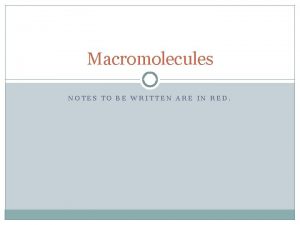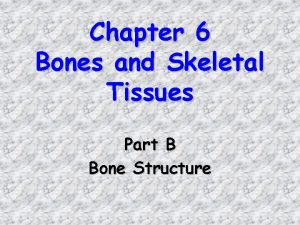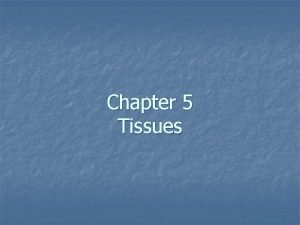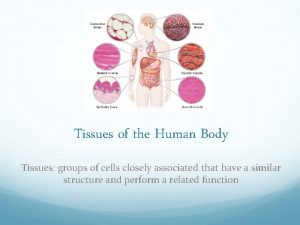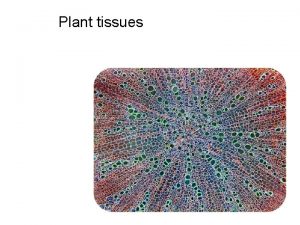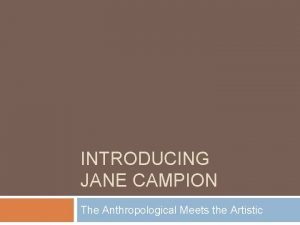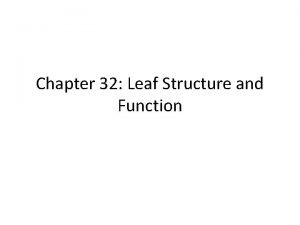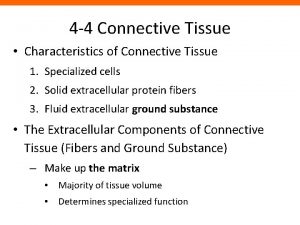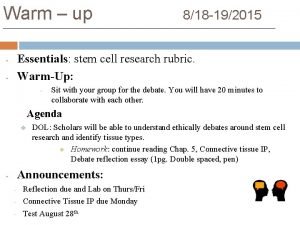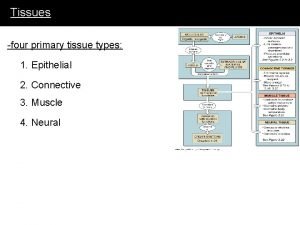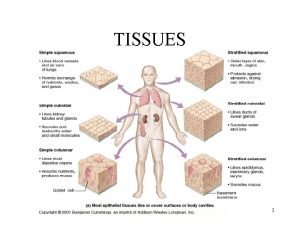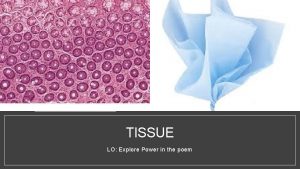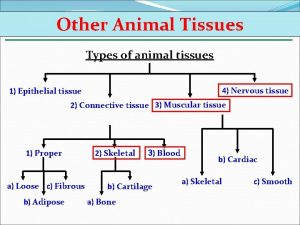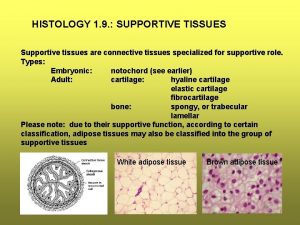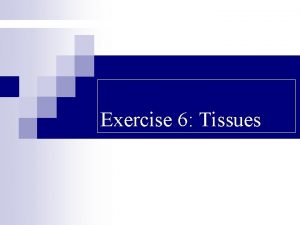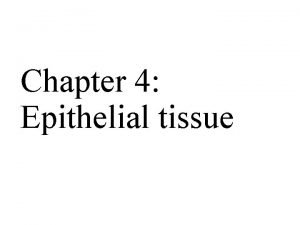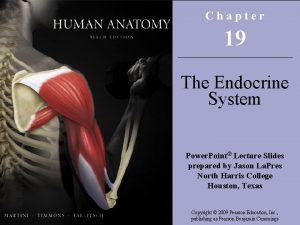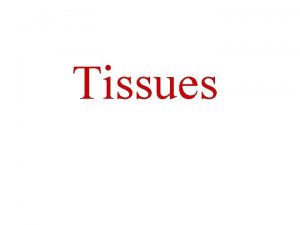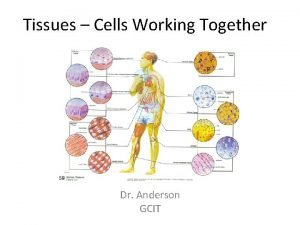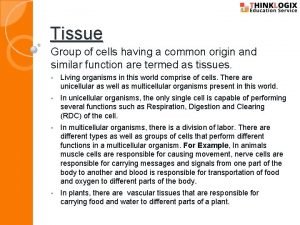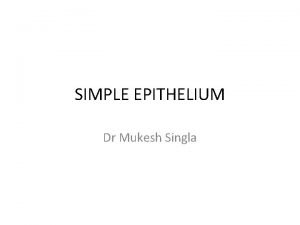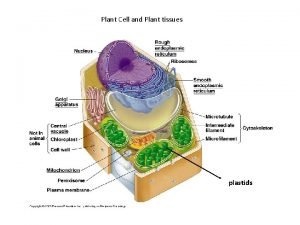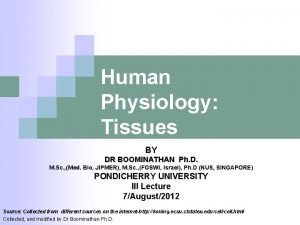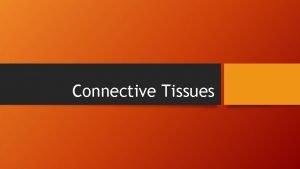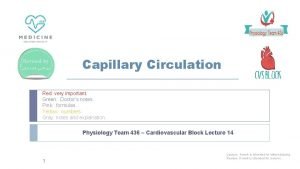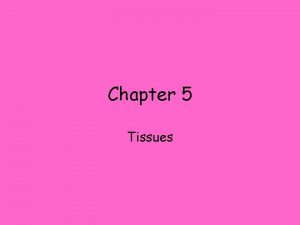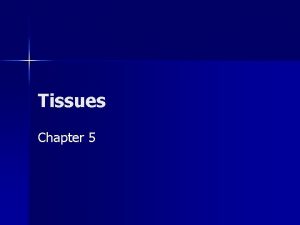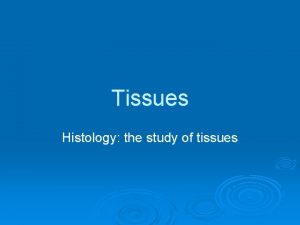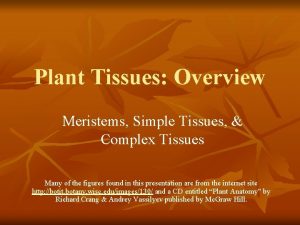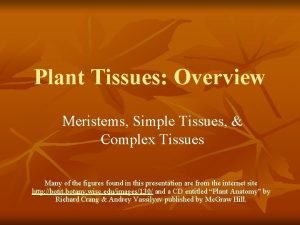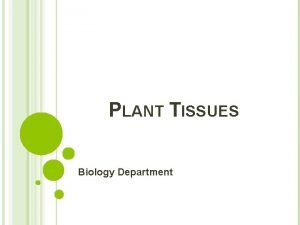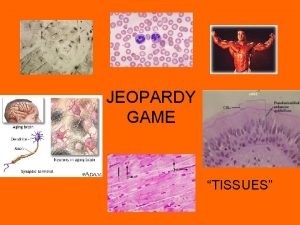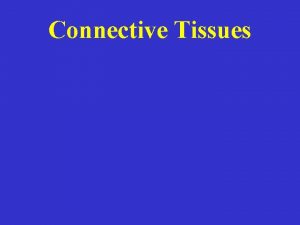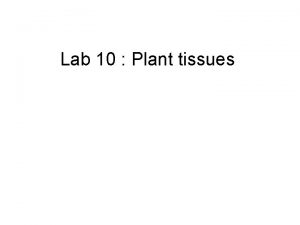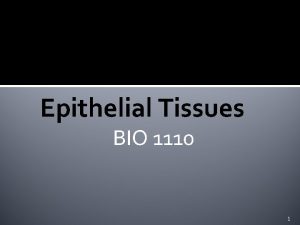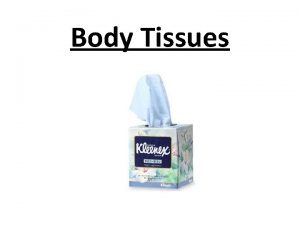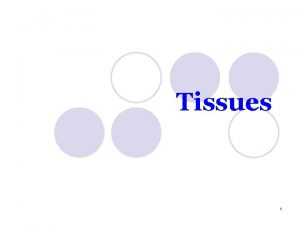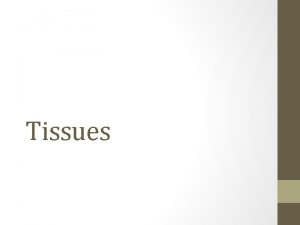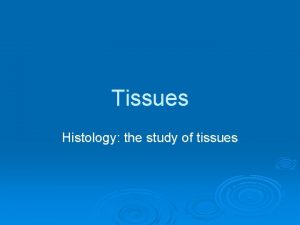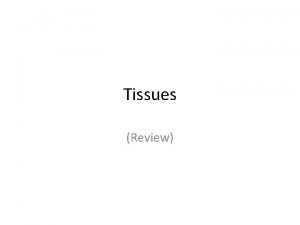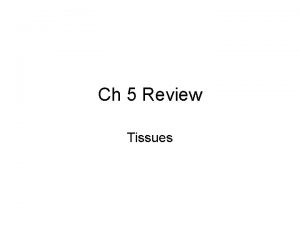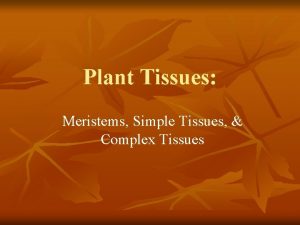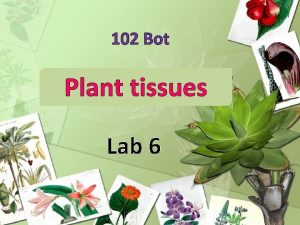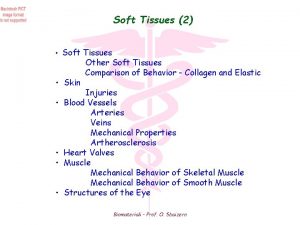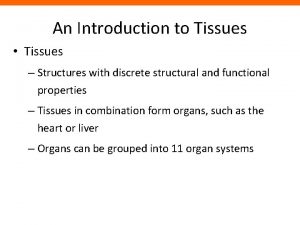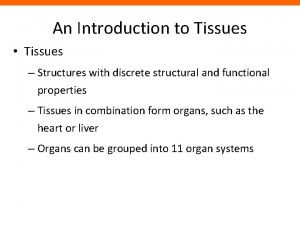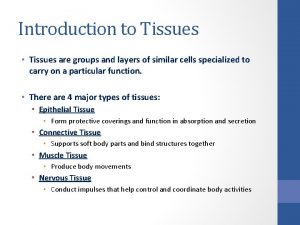Tissues Chapter 3 Part 2 Introduction to Tissues



















































- Slides: 51

Tissues Chapter 3: Part 2

Introduction to Tissues l l Groups of cells that are similar in structure and function. Organs contain several tissue types. – Arrangement of tissue determines the structure and ability of organs. http: //people. eku. edu/ritchisong/RITCHISO//tissues. gif

Introduction to Tissues l Many Types of Tissues – – Epithelial Tissue Covering Connective Tissue Support Muscle Tissue Movement Nervous Tissue Control

Epithelial Tissues l l The lining, covering, and glandular tissues General Functions: – – Protection Absorption Filtration Secretion

Epithelial Tissues l Special Characteristics: – – – Apical Surface Fit closely together to form continuous sheets Apical Surface- a free surface or edge that is exposed Basement Membranelower surface Avascular- no blood vessels Regenerate easily when well nourished. http: //occawlonline. pearsoned. com/bookbind/pubbooks/ehapplace/chapter 3/deluxe. html Basement Membrane

Classification of Epithelial Tissues l Relative Number of Cell Layers – – l Simple (One cell layer) Stratified (More than one cell layer) Description of Cell Shape – – – Squamous (Flat) Cuboidal Columnar

Simple Squamous Epithelium l Found in the membranes for filtration or rapid diffusion – – – Air sacs in lungs Walls of Capillaries Serous Membranes (cover organs)

Simple Cuboidal Epithelium l Found in: – – – Glands and their ducts Walls of kidney tubules Outer surface of ovaries

Simple Columnar Epithelium l Goblet Cells – l Mucous membranes The entire length of the digestive tract

Pseudostratified Columnar Epithelium l Some cells are shorter than others – – Nuclei appear at different levels Ciliated tissue lines most of the respiratory tract.

Stratified Squamous Epithelium l l Most Common Areas subject to friction – – – Esophagus Mouth Epidermis

Stratified Cuboidal/Columnar Epithelium l Very Rare in the Body – Ducts of large glands

Transitional Epithelium l Able to stretch – – – Urinary bladder Ureters Part of urethra

Glandular Epithelium l l Glands consist of one or more cells that make and secrete a particular product Secretions are proteins in an aqueous solution produced by a gland. Adrenaline Cortisol http: //upload. wikimedia. org/wikipedia/commons/1/14/Illu_adrenal_gland. jpg

Glandular Tissue l Endocrine Glands – – – Lose connection to surface (ductless) Secretions diffuse directly into the blood Produce hormones l l l Thyroid Adrenals Pituitary http: //upload. wikimedia. org/wikipedia/en/c/c 6/Illu_endocrine_system. jpg

Glandular Tissue l Exocrine Glands – – – Secretions empty onto epithelial surface (ducts) Sweat and oil glands Liver and pancreas http: //www. pg. com/science/skincare/Skin_tws_34/skin_34_02. jpg

Connective Tissues l Found everywhere in the body. – l The most abundant and widely distributed tissues Functions – – – Binds body tissues together Supports the body Provides protection

Characteristics of Connective Tissues l Variations in blood supply – – l Some tissues are well vascularized Some have a poor blood supply or are avascular Extracellular Matrix – – The nonliving material that surrounds the cells Two main elements l l Ground Substance Fibers

Extracellular Matrix l Ground Substance – l mostly water along with adhesion proteins and polysaccharide molecules Fibers – – Produced by the cell Three Types: l l l Collagen fibers Elastic fibers Reticular fibers

Bone l l Osseous tissue Composed of: – – – l Bone cells in lacunae Hard matrix of calcium salts Large number of collagen fibers Used to protect and support the body

Osseous Tissue

Hyaline Cartilage l l Most cartilage Composed of: – – l Abundant collagen fibers Rubbery matrix The entire fetal skeleton is hyaline cartilage

Hyaline Cartilage

Elastic Cartilage l l Provides elasticity Example: – Supports the external ear http: //dictionary. laborlawtalk. com/Earlobe_stretching

Fibrocartilage l l Highly compressable Example: – Forms cushion-like discs in between vertebrae

Fibrocartilage

Dense Connective Tissue l l l Main matrix element is collagen fibers Cells are fibroblasts Examples: – – Tendon- attach muscle to bone Ligament- attach bone to bone

Dense Connective Tissue

Areolar Connective Tissue l l Most widely distributed connective tissue Soft, pliable tissue Contains all fiber types Can soak up excess fluid – Edema- when the tissue soaks up excess fluid, the area swells and becomes puffy

Areolar Tissue

Adipose Tissue l l l Matrix is an areolar tissue in which fat globules predominate Many cells contain large lipid deposits Functions: – – – Insulates the body Protects some organs Serves as a site of fluid storage

Adipose Tissue

Reticular Connective Tissue l l Delicate network of interwoven fibers Forms stroma (internal supporting network) of lymphoid organs – – – Lymph nodes Spleen Bone marrow

Reticular Tissue

Blood l l l Blood cells surrounded by fluid matrix Fibers are visible during clotting Functions as transport vehicle for materials

Blood

Muscular Tissues l l The purpose of muscle tissues is to produce movement. Three types of muscle tissues – – – Skeletal Cardiac Smooth

Skeletal Muscle l l Can be controlled voluntarily Cells attach to connective tissue Cells are striated Cells have more than one nucleus

Skeletal Muscle

Cardiac Muscle l l l Found only in the heart Function is to pump blood (involuntarily) Cells are attached together by intercalated disks – l Gap junctions allow ions o pass freely from cell to cell Cells are striated and have only one nucleus

Cardiac Muscle

Smooth Muscle l l Also called visceral muscle Involuntary muscle Surrounds hollow organs Cells: – – – Are spindle-shaped Have one nucleus Has no visible striations

Smooth Muscle

Nervous Tissues l l Neurons and the nerve support cells Functions to send impulses to other parts of the body – – l Irritability Conductivity Supporting cells- insulate, support and protect the delicate neurons

Nervous Tissue

Nervous Tissue

Tissue Repair l Regeneration – l Fibrosis – – l Replacement of destroyed tissue by the same kind of cells Repair by dense connective tissue Forms Scar Tissue The type of tissue repair depends on: – – The type of tissue injured The severity of the injury

The Events of Tissue Repair l The capillaries become very permeable – – l Granulation tissue forms – l Allows clotting proteins into the region Walls off the injured area to prevent bacteria from spreading to other areas Pink tissue composed of capillaries Surface Epithelium regenerates

Tissue Repair · · Tissues that regenerate easily · Epithelial tissue · Fibrous connective tissue and bone Tissues that regenerate poorly · · Skeletal muscle Tissues that are replaced largely with scar tissue · Cardiac muscle · Nervous tissue within the brain and spinal cord

Developmental Aspects of Tissues l Life begins as a single cell – – l l Cells undergo mitosis to product the multicellular body Cells continue to divide through puberty Cells that are exposed to friction must replace lost cells Connective tissue continues to divide as it is involved in tissue repair Muscle tissue ends cell division by the end of puberty Nervous tissue is amiotic shortly after birth

Other terms associated with Cells and Tissues l Neoplasm- an abnormal mass of proliferating cells – l Hyperplasia – l May be benign or cancerous Certain body tissues may enlarge because there is some local irritant or condition that stimulates the cells Atrophy – A decrease in size that occurs when an area loses its normal stimulation http: //www. ch. ic. ac. uk/local/projects/burgoine/cancer_cell_division. jpg
 Body tissue
Body tissue Body tissues worksheet
Body tissues worksheet Body tissues chapter 3 cells and tissues
Body tissues chapter 3 cells and tissues Chapter 3 cells and tissues
Chapter 3 cells and tissues Eisonophil
Eisonophil What macromolecule is a prominent part of animal tissues
What macromolecule is a prominent part of animal tissues Chapter 6 bones and skeletal tissues
Chapter 6 bones and skeletal tissues Which part of the cell contains genetic material
Which part of the cell contains genetic material Chapter 3 cells and tissues figure 3-7
Chapter 3 cells and tissues figure 3-7 Chapter 5 tissues
Chapter 5 tissues Chapter 3 cells and tissues figure 3-1
Chapter 3 cells and tissues figure 3-1 Addition symbol
Addition symbol Part to part ratio definition
Part to part ratio definition Brainpop ratios
Brainpop ratios Technical description
Technical description 3 parts of bar
3 parts of bar The phase of the moon you see depends on ______.
The phase of the moon you see depends on ______. Part to part variation
Part to part variation Specialized connective tissue
Specialized connective tissue Http://www.biologycorner.com/anatomy/histology/
Http://www.biologycorner.com/anatomy/histology/ 3 tissues of a plant
3 tissues of a plant 3 tissues of a plant
3 tissues of a plant Stone cells in plants
Stone cells in plants Jane campion tissues
Jane campion tissues Mesophyll function
Mesophyll function Tissues causes of civil war
Tissues causes of civil war Epithelium location
Epithelium location Connective tissue characteristics
Connective tissue characteristics Tissues are groups of similar cells working together to
Tissues are groups of similar cells working together to Genetic effects on gene expression across human tissues
Genetic effects on gene expression across human tissues Areolar connective tissue location and function
Areolar connective tissue location and function Types of tissues
Types of tissues What are the four primary tissue types
What are the four primary tissue types Tissues are groups of similar cells working together to
Tissues are groups of similar cells working together to Connective tissue poem
Connective tissue poem Types of tissues
Types of tissues Division of anatomy
Division of anatomy Supportive tissue
Supportive tissue Exercise 6 tissues
Exercise 6 tissues Identify connective tissue quiz
Identify connective tissue quiz Tissue type
Tissue type Endocrine tissues
Endocrine tissues Four major tissues
Four major tissues Tissues working together
Tissues working together Tissue is a group of cells having common origin
Tissue is a group of cells having common origin Tissue in cardiovascular system
Tissue in cardiovascular system Simple columnar epithelial tissue function
Simple columnar epithelial tissue function Plastid
Plastid Tissues definition
Tissues definition Acute and chronic apical periodontitis
Acute and chronic apical periodontitis What do all connective tissues have in common
What do all connective tissues have in common Where are capillary beds located
Where are capillary beds located





